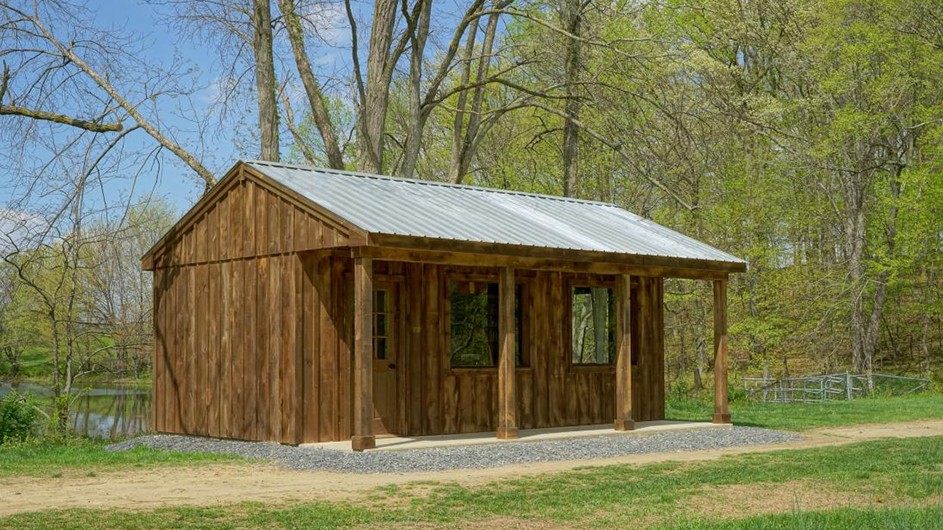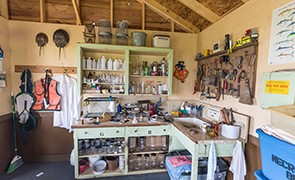Artist Mark Dion Engages With Climate Change and the Uncertainty of Science in His Work
In an online event, he discusses his process and the relationship between art and science with Maureen Raymo, co-founding dean of Columbia Climate School.

On October 7, 2021, in an online School of the Arts event, visual artist Mark Dion presented his recent work, including the installation The Field Station of the Melancholy Marine Biologist, which opened on October 8 on Governors Island. Maureen Raymo, director of Lamont-Doherty Earth Observatory and co-founding dean of Columbia Climate School, introduced Dion and spoke with him after his presentation. The event was co-presented by Lamont-Doherty and the Trust for Governors Island.
During the Q&A portion of the event, an audience member asked Dion, “Do you believe that your work in some way is a ritual of mourning about science and climate change?”
“That’s sort of the ‘melancholy’ in the Melancholy Marine Biologist,” Dion explained.
An Abandoned Research Facility Frozen in Time
Newly updated for its installation on Governors Island, The Field Station of the Melancholy Marine Biologist (originally created in 2017 and exhibited at Storm King Art Center in Cornwall, New York, and in New Orleans) takes the form of an abandoned research facility. Within the small building is a scene frozen in time, with scientific instruments, objects, artifacts, and specimens left as though the researcher, confronted by the catastrophic effects of climate change on the natural world, has abandoned the facility in futility.
“My approach,” Dion said, “is to be a visual culture historian trying to look at how we evolved this suicidal relationship to the planet, and a lot of that is based on the history of ideas, and the history of things.”
Dion’s lecture, accompanied by photographs of his work and process, cycled through a selection of his major projects about oceanography and marine species.
The artist traced this interest back to the whaling museum in New Bedford, Massachusetts, which he visited as a child. The museum gathered artifacts, paintings, and animal specimens together, organized around a concept—the ocean—like the Wunderkammern that would come to figure prominently in Dion’s work. A Wunderkammer, or cabinet of curiosities, dates from the late Renaissance, and was used to store and exhibit a wide variety of objects, often rare and esoteric, which, through their selection, told a particular story about history and the natural world.
An Artist’s Great Respect for the Scientific Process
The relationship of professional science and amateurism, like that of the early practitioners of the Wunderkammern, is one that Dion interacts with out of great respect for the scientific process.

In an early project from 1992, The Department of Marine Animal Identification of the City of New York (Chinatown Division), Dion gathered, preserved, and attempted to catalogue the sea creatures he found at a Chinatown market—“a challenging job even for the people who know what they’re doing,” he said.
Part of Dion’s aim in Marine Animal Identification was to “show not my mastery,” he said, “but the struggle—how difficult it is for me as a layperson to adopt or shadow some elements of the methodology of another discipline.”
The idea of struggle, process, and failure—both in science and in art—was a theme of Dion’s presentation. For him, “process is the most interesting part of being an artist.”
Mastery and Final Definitions Versus Struggle and Tentative Solutions
Dion and Raymo discussed how the scientific economy encourages an emphasis on mastery, when, in reality, things don’t always go as planned. “Research is a struggle,” Raymo said.
Scientific journalists, Dion added, can seem “trapped in the idea of presenting science with a degree of certainty, which is what people often want from science. But it’s really dynamic and changing, and that, to me, is the most exciting thing about science.”
Engaging with the history of science to show it as a living, breathing thing is one of Dion’s most distinctive impulses as an artist: “It’s not about defining things forever; it’s about tentative solutions for what we know right now.”
How Personal Choices Affect Climate Change
The relationship of laypeople to science resurfaced when the talk turned to the climate emergency. Dion and Raymo discussed the responsibility individuals bear versus that of industry leaders.
Consumption, Raymo said, is at the root of ocean warming and acidification, overfishing, and plastics in the sea. As such, “we share this personal responsibility through our choices, but the system doesn’t make it easy for us to have good choices.”
Dion agreed, emphasizing that capitalism encourages us to lay blame on the consumer. “As a policy, to destroy mass transit, and then blame the public for driving too much,” he said, is “intentionally misleading.”
What earlier in his career he considered to be a crisis of information about climate change Dion now recognizes as “a problem of will, and a problem of leadership, and of calling out the people who are actually responsible for this,” he said.
Folly-style works like The Field Station of the Melancholy Marine Biologist allow Dion to bring the sometimes rarefied world of installation art to the public, and to actively engage the layperson. “I want viewers to feel like detectives,” he said.
Indeed, implicating the viewer in the world of the Melancholy Marine Biologist is both an invitation to mourn what has been lost, and also a haunting call to action on the climate crisis. As Dion observed in his closing comments, “I can’t think of a more important thing for artists to be thinking about and dealing with.”
Emily Johnson is an MFA student in the fiction concentration of the writing program at the School of the Arts.